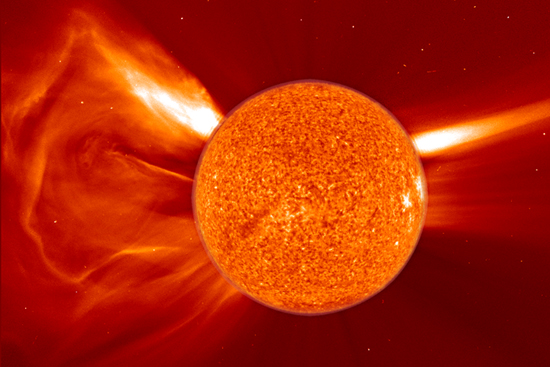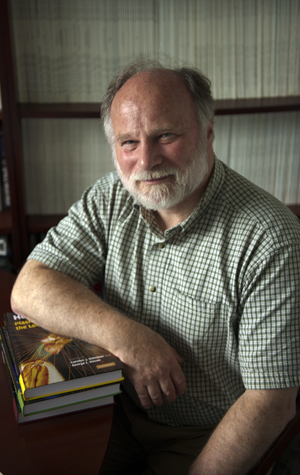Detecting the Perfect Solar Storm
Astronomers develop an early warning system for super solar flares

A coronal mass ejection, or CME, is a sudden and violent outburst of hot gas and magnetic fields in the outer solar atmosphere. Image courtesy of NASA
On September 1, 1859, British astronomer Richard Carrington was sketching sunspots through a telescope when he saw a bright, oval-shaped light expanding outward from the sun. About 18 hours later, brilliant auroras colored the night sky as far south as the Caribbean, and Earth’s fledgling telegraph systems went berserk: wires melted, sparks from the wires shocked operators and set the telegraph paper on fire, and telegraph networks across Europe and North America failed.
The culprit was a solar storm: essentially a large burp of plasma erupting from the sun and streaming outward through the solar system. While storms as strong as the “Carrington Event” are very rare, they are more likely to occur during the peaks of 11-year solar cycles—with the next peak scheduled to hit in 2013.
While in 1859 the damage was relatively minor, today humans are totally dependent on electricity to power things from communication systems to the pumps that bring drinkable water into city pipes. If a massive storm like the Carrington Event strikes Earth again, it could cripple the power grid for years, destroy orbiting satellites, and cause an estimated $2 trillion in damages, according to a recent report from the U.S. National Academy of Sciences.

The question is not whether such a storm will recur, but when, and then how to protect against it. W. Jeffrey Hughes, a College of Arts & Sciences professor of astronomy and director of BU’s Center for Integrated Space Weather Modeling, has spent the past decade leading the development of an early warning system to detect incoming solar storms. Backed by a $40 million National Science Foundation grant, Hughes and his team created a prediction model that will enable us to prepare for the worst.
A warning system using this prediction model became fully operational this past fall at the National Oceanic and Atmospheric Administration (NOAA)’s Space Weather Prediction Center in Boulder, Co. The warning system will give two or three days’ notice of impending solar storms—basically the time it takes for a storm to travel from the sun to Earth. It will estimate the speed of the storm—faster storms cause more damage—but cannot tell us one crucial piece of information: the direction of the storm’s magnetic field.
The direction of a solar storm’s magnetic field is vitally important. If a storm hits Earth’s magnetosphere with the storm’s magnetic field pointing north (paralleling Earth’s magnetic field), the storm will bounce off of the magnetosphere, doing little harm. This is equivalent to what happens when two magnets repulse each other. However, if the storm happens to hit Earth with its field pointing south, we have a big problem.
“If the magnetic field in the solar wind points in the opposite direction from Earth’s magnetic field, then they can effectively annihilate each other, allowing the solar wind to couple [transfer] energy into the magnetosphere,” says Hughes. “This is the single biggest factor in determining whether we have a super storm.”
In this scenario, the interaction between the solar wind and Earth’s magnetosphere would generate electrical turmoil in the upper atmosphere, causing magnetic variations in Earth’s internal magnetic field. These magnetic variations would, in turn, generate electrical currents on Earth’s surface.

Strong surface currents would enter the wires of our power grid, overloading and destroying the massive transformers that transmit electricity across long distances. Replacing these transformers would likely take years, since only a few are manufactured each year. In the meantime, only those living close to power plants would likely still have power, while vast populations would experience blackouts. Many military and commercial communications satellites would be destroyed. It would be one of the worst natural disasters in modern history.
The new NOAA warning system would allow operators to power-down satellites, protecting them from a major solar storm. It also would give first responders time to prepare for disaster. To really protect the power grid, we would need to build what essentially would be massive surge protectors at key points. According to solar storm expert John Kappenman in a report for the Oak Ridge National Lab, enormous surge protectors could be installed near transformers at a cost of around $1 billion. However, the U.S. government has not allocated the funding for such a project.
While the likelihood of a super storm like the Carrington Event occurring during each solar cycle is very low, it could happen. “Each solar maximum takes us by surprise in some way, usually because we’ve developed some new technology in the 11 years since that last one without realizing how it’s vulnerable,” says Hughes. “I’m sure we’re in for another surprise in 2013. It will certainly be important for the electric power grid to be fully prepared.”
This story was originally published in the spring 2012 issue of arts&sciences.
Jeremy Schwab can be reached at jschwab@bu.edu.
Comments & Discussion
Boston University moderates comments to facilitate an informed, substantive, civil conversation. Abusive, profane, self-promotional, misleading, incoherent or off-topic comments will be rejected. Moderators are staffed during regular business hours (EST) and can only accept comments written in English. Statistics or facts must include a citation or a link to the citation.